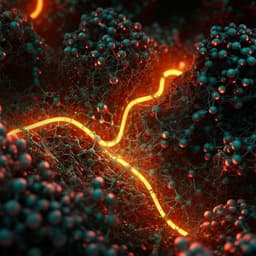
Engineering and Technology
Controlling lithium cobalt oxide phase transition using molten fluoride salt for improved lithium-ion batteries
M. Mikami, J. Saito, et al.
Discover an innovative method to enhance the performance of LiCoO₂, a popular lithium-ion battery cathode known for its high energy density. Researchers Mayumi Mikami and colleagues have successfully controlled a harmful phase transition through MgF₂-LiF molten salt treatment, leading to impressive electrochemical improvements at elevated voltages.
~3 min • Beginner • English
Introduction
The widespread adoption of high-capacity portable electronics has sustained demand for high-energy-density lithium-ion batteries. LiCoO₂ (LCO) remains a leading cathode due to its high theoretical capacity (274 mAh g⁻¹) and energy density. However, at high cut-off voltages required to approach theoretical capacity, LCO suffers degradation mechanisms including surface side reactions, Co dissolution, oxygen release, structural changes, and crack formation, which limit practical operation to ~4.55 V vs Li⁺/Li and ~200 mAh g⁻¹ in full cells. Structurally, LCO (O3, R3m) undergoes O3 → H1-3 → O1 phase transitions upon deep delithiation; gliding of CoO₂ slabs induces stress, defects, and cracks that impair cycling stability, especially above 4.55 V. Preventing the O3 → H1-3 transition is thus critical for stable high-voltage cycling. Prior approaches have included elemental doping, surface coatings, and electrolyte optimization. Mg doping and Mg-containing coatings have been reported to enhance high-voltage performance via a proposed pillar effect of Mg²⁺ in Li layers, yet achieving robust reversibility at high voltage remains challenging. This study introduces a molten fluoride salt-assisted strategy to integrate Mg into LCO and form a coherent Mg-enriched surface layer, with additional Ni and Al incorporation to further improve electrochemical stability.
Literature Review
Past studies have identified multiple degradation pathways in high-voltage LCO, including Co dissolution, oxygen release, structural transitions, and crack formation (refs 4–20). Elemental doping (e.g., Mg, Mn, Al) can stabilize structure and improve cycling (refs 13–15), while surface coatings (e.g., MgO, Al₂O₃, AlPO₄, TiO₂) mitigate interfacial reactions and oxygen loss (refs 16–24). Electrolyte improvements, such as fluorinated solvents and additives (FEC, PS, VC), can suppress parasitic reactions (refs 25–27). The O3 → H1–3 transition during deep delithiation is a key instability (refs 1,2,28–34). Mg²⁺ incorporation has been proposed to act as a pillar in Li layers, inhibiting slab gliding and improving high-voltage stability (refs 15,16,21,23). However, conventional solid-state mixing and coating often yield slow, inhomogeneous Mg diffusion due to MgO’s high thermal stability and low Mg solubility in LCO, limiting effectiveness. These insights motivate a reaction-accelerated approach using molten fluoride salts to enhance Mg diffusion/doping and create protective surface chemistries.
Methodology
Synthesis via molten fluoride salt-assisted modification:
- Starting materials: LiCoO₂ (pristine C-10N, D50=12.5 µm), MgF₂, LiF, Ni(OH)₂, Al(OH)₃.
- Preheat pristine LCO at 850 °C for 2 h in O₂.
- First addition/heating: mix preheated LCO:MgF₂:LiF at 1:0.01:0.003 molar ratio; heat at 900 °C for 20 h in O₂ to form molten MgF₂–LiF eutectic (DSC eutectic point 731.4 °C). DSC with MgF₂–LiF–LCO shows an endothermic peak at 814.5 °C, indicating reaction at the LCO surface near decomposition temperature. Molten salt wets particle surfaces and accelerates Mg diffusion/doping and excess Mg coating.
- Second addition/heating: add Ni(OH)₂ and Al(OH)₃ at LCO:Ni(OH)₂:Al(OH)₃ = 1:0.005:0.005; heat at 850 °C for 10 h in O₂.
- Comparative samples: M-LCO (Mg(OH)₂ only), MF-LCO (MgF₂–LiF), FN-LCO (LiF+Ni), FA-LCO (LiF+Al), FNA-LCO (LiF+Ni+Al), F-LCO (LiF only), NA-LCO (Ni+Al without LiF/MgF₂), MFN-LCO (MgF₂–LiF+Ni), MFA-LCO (MgF₂–LiF+Al), and heated LCO (no additives) following analogous steps.
Materials characterization:
- XRD (Bruker D8 ADVANCE, Cu Kα) with Rietveld refinement (DIFFRAC TOPAS V6) to identify phases and lattice parameters; ex situ XRD on electrodes charged to defined voltages/cycles using airtight holders.
- SEM/SEM-EDX (Hitachi SU4800/SU8030; HORIBA EMAX Evolution EX-370) for morphology and elemental mapping.
- ICP-MS (Agilent 8900) and EPMA (JEOL JXA-iHP200F) for bulk composition and cross-sectional elemental ratios.
- XPS (ULVAC-PHI Quantera-SXM, Al Kα) for surface chemistry (Mg, F states; evidence of oxyfluoride species) and surface enrichment quantification.
- STEM and NBED (JEOL JEM-ARM200F; JED-2300T for STEM-EDX) for atomic-scale structure at surfaces (layered rock salt core vs rock salt shell, coherence at interface) and post-cycling surface phase analysis.
- DSC (Rigaku Thermo Plus EV02 DSC8271) from RT to 1000 °C to determine eutectic behavior and reaction temperatures.
Electrode and cell fabrication:
- Half-cells (CR2032): cathode slurry 95 wt% active, 3 wt% carbon black, 2 wt% PVDF in NMP; coat on Al foil; typical loading ~7 mg cm⁻² (variants: 20 and 3 mg cm⁻²). Counter: Li metal foil (0.6 mm). Separator: Celgard 2400 PP. Electrolytes: (i) 1 M LiPF₆ in EC/DEC (3:7 vol) + 2 wt% VC (commonly used); (ii) 1 M LiPF₆ in FEC/MTFP (2:8 vol) + 5 wt% 1,3-propanesultone (fluorinated), used as specified.
- Full cells (pouch): MFNA-LCO cathode as above; anode 96 wt% synthetic graphite (MCMB G10), 1 wt% VGCF-H, 1 wt% CMC, 2 wt% SBR in water on Cu foil. Cathode/anode loadings 10.6/7.6 mg cm⁻²; sizes 41×50 mm (cathode), 45×53 mm (anode). Targeted N/P ratio ~0.8 and 40 mAh cell capacity. Separator: PP Celgard 2400. Electrolyte: 1 M LiPF₆ in FEC/MTFP (2:8 vol).
Electrochemical testing:
- Half-cell cycling (2.5–4.6 or 2.5–4.7 V vs Li⁺/Li) at 25 °C: CCCV charge 100 mA g⁻¹ to 10 mA g⁻¹ cutoff; CC discharge 100 mA g⁻¹; 10 min rests. Rate tests (2.5–4.7 V): CCCV charge 100 mA g⁻¹; CC discharge currents 40, 100, 200, 400, 600, 1000, 2000, then 100 mA g⁻¹ every five cycles. dQ/dV at 10 mA g⁻¹ over 2.5–4.7 V after conditioning. Additional protocols with fluorinated electrolyte at 200 mA g⁻¹ for specific experiments.
- Full-cell cycling (3.0–4.5 or 3.0–4.6 V vs graphite) at 25 °C: CCCV charge 40 mA g⁻¹ to 4 mA g⁻¹; CC discharge 40 mA g⁻¹; 1 min rests.
Analytical design to probe mechanism:
- Ex situ XRD on electrodes charged to 4.5–4.7 V at specific cycles (1st, 2nd, 5th, 50th) to detect O3, H1–3, and emergent O3′ phase behavior.
- Comparative study across modified samples (M-, MF-, FN-, FA-, FNA-, MFN-, MFA-LCO) to isolate roles of Mg, molten fluoride, Ni, and Al.
Key Findings
- Molten MgF₂–LiF treatment accelerates Mg diffusion/doping into LCO bulk and forms an Mg-enriched, ~1 nm rock salt surface shell coherently bonded to the layered rock salt core. Surface shows high Mg and F enrichment by XPS (Co:Mg:F ≈ 1:0.93:0.53 at surface), while bulk Mg content is low but measurable (ICP-MS/EPMA Co:Mg ≈ 1:0.009–0.0093).
- Structural evolution under high voltage: Ex situ XRD shows that pristine LCO forms the H1–3 phase upon first charge to 4.6–4.7 V (e.g., 239.4 mAh g⁻¹ at 4.7 V, x≈0.13), consistent with literature, and suffers severe degradation by the 5th charge (capacity 145.6 mAh g⁻¹, x≈0.47, and lack of O3→H1–3 transitions due to damaged surface and hindered Li diffusion). In contrast, MFNA-LCO charged to 4.7 V exhibits two O3-like patterns with no H1–3 signature initially; a distinct compressed O3′ phase emerges and becomes the dominant single phase by the 5th charge (225.3 mAh g⁻¹, x≈0.18), persisting to the 50th charge (214.5 mAh g⁻¹, x≈0.22) with only weak H1–3 peaks. Rietveld analysis shows the O3′ phase has a significantly smaller c lattice parameter than conventional highly delithiated O3.
- Electrochemical performance (half-cells, common electrolyte): MFNA-LCO demonstrates markedly improved high-voltage cycling stability compared to pristine LCO. Capacity retention after 100 cycles: 96.4% (205.2 mAh g⁻¹) at 2.5–4.6 V; 72.7% (160.9 mAh g⁻¹) at 2.5–4.7 V. High Coulombic efficiencies indicate suppressed oxidative electrolyte decomposition due to the protective surface layer. MFNA-LCO shows superior rate capability relative to pristine LCO over 0.2–10 C (details in Fig. 4d).
- Full-cell performance (vs graphite, fluorinated electrolyte): Pouch cells with MFNA-LCO exhibit stable cycling between 3.0–4.5 and 3.0–4.6 V with high Coulombic efficiency; the Ragone analysis (Supplementary) indicates highest energy density among practical cathode materials tested.
- Post-cycling integrity: After 100 cycles, ex situ XRD of discharged electrodes shows pristine LCO with broadened peaks (low crystallinity) and extensive cracking (SEM), with ~3 nm spinel/rock salt surface layers forming due to oxygen release. MFNA-LCO maintains sharp XRD peaks (high crystallinity), minimal cracking, and preserves the ~1 nm rock salt surface without spinel formation. High surface concentrations of Mg, Ni, Al, and F inhibit oxygen release and protect against HF attack, preserving Li-ion interfacial transport.
- Mechanistic isolation: Only samples treated with MgF₂–LiF (MF-LCO and MFNA-LCO) combine high cycling stability with absence of H1–3 in highly charged ex situ XRD, indicating molten fluoride-enabled Mg incorporation is essential for O3′ formation and H1–3 suppression. LiF alone primarily serves as a reaction accelerator rather than improving cycling by itself. Adding Ni and Al to MF-LCO (MFN-, MFA-, MFNA-LCO) shows MFNA-LCO has the highest capacity retention and Coulombic efficiency (e.g., 3rd cycle at 4.7 V: 99.79% for MFNA vs 99.48% MFN and 99.34% MFA), implying synergistic contributions of Ni and Al to surface/interfacial stability.
Discussion
The results demonstrate that molten fluoride salt processing enables effective Mg incorporation into LCO, overcoming limitations of conventional solid-state diffusion. The Mg-enriched rock salt surface and Mg substituted in Li layers (pillar effect) stabilize the layered framework by preventing CoO₂ slab gliding, thereby inhibiting the O3 → H1–3 transition during deep delithiation. Ex situ XRD reveals the emergence of a compressed O3′ phase with identical symmetry to O3 but reduced unit cell volume, which replaces H1–3 upon high-voltage charging in MFNA-LCO and remains largely stable over extended cycling. The coherent bonding between the ~1 nm rock salt shell and the layered core maintains structural integrity and facilitates Li transport; high surface concentrations of Mg, Ni, Al, and F suppress oxygen release and protect against HF-induced degradation, reducing interfacial impedance growth and crack formation. Comparative studies show that LiF’s primary role is to form a molten eutectic with MgF₂ that accelerates Mg diffusion/coating; without MgF₂, LiF does not yield similar cycling benefits. Incorporation of Ni and Al further improves Coulombic efficiency and capacity retention, likely via additional surface stabilization and subsurface solid solution effects. Collectively, these factors enhance rate and cycling performance at high voltages, addressing the central challenge of phase-transition-driven degradation in LCO and offering a strategy potentially applicable to other layered oxide cathodes where slab gliding and oxygen loss are problematic.
Conclusion
This work introduces a molten fluoride salt-assisted strategy to diffuse and dope Mg into LiCoO₂ and to form a coherent Mg-enriched rock salt surface layer, yielding suppression of the harmful O3 → H1–3 transition during high-voltage operation. Ex situ XRD confirms the formation of a distinct compressed O3′ phase at 4.7 V in MFNA-LCO, replacing H1–3 and remaining stable over many cycles. MFNA-LCO achieves excellent high-voltage cycling performance in half-cells (capacity retention: 96.4% at 4.6 V; 72.7% at 4.7 V after 100 cycles) and stable full-cell performance versus graphite, with high Coulombic efficiencies and minimized structural degradation (reduced cracking and oxygen release). The approach provides guidelines for mitigating phase-transition-induced degradation, enabling ultra-high energy density LCO cathodes and informing broader strategies for layered oxide stabilization. Future work could explore in situ/operando structural probes of O3′ formation, quantitative diffusion studies of Mg/Ni/Al gradients, optimization of surface layer thickness and composition, and extension to other cathode chemistries and scalable manufacturing conditions.
Limitations
The study does not explicitly enumerate limitations. Structural analysis relies on ex situ XRD rather than in situ/operando measurements, which may miss transient phases. Quantitative in-depth profiles of Mg/Ni/Al/F distributions are inferred from multiple techniques but not fully resolved with high-resolution depth profiling. Long-term calendar aging, high-temperature cycling, and broader electrolyte/format validations beyond the tested conditions are not reported.
Related Publications
Explore these studies to deepen your understanding of the subject.







